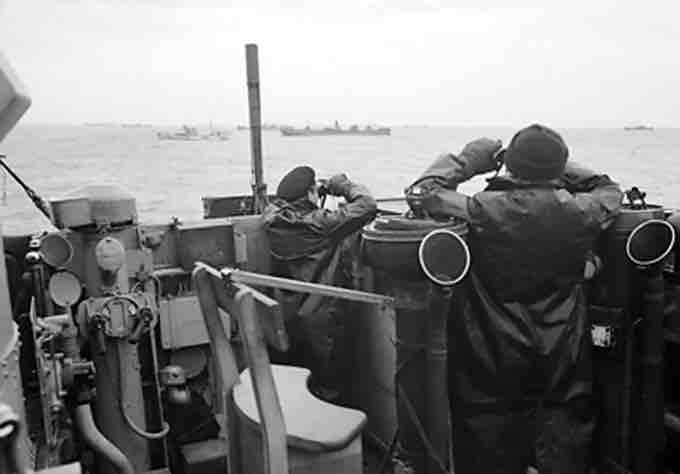THE BATTLE OF THE ATLANTIC
The Battle of the Atlantic was the longest, continuous military campaign in World War II, running from 1939 to the defeat of Germany in 1945. At its core was the Allied naval blockade of Germany, announced the day after the declaration of war and Germany's subsequent counter-blockade. It was at its height from mid-1940 until the end of 1943. The Battle of the Atlantic pitted U-boats and other warships of the Kriegsmarine (German Navy) and aircraft of the Luftwaffe (German Air Force) against the Royal Canadian Navy, Royal Navy, the United States Navy, and Allied merchant shipping. Allied merchant shipping, or convoys. The convoys, coming mainly from North America and predominantly going to the United Kingdom and the Soviet Union, were protected for the most part by the British and Canadian navies and air forces. These forces were aided by ships and aircraft of the United States from September 13, 1941. The Germans were joined by submarines of the Italian Royal Navy (Regia Marina) after their Axis ally Italy entered the war on June 10, 1940.
The name "Battle of the Atlantic" was coined by Winston Churchill in February 1941. It has been called the "longest, largest, and most complex" naval battle in history. The campaign began immediately after the European war began and lasted six years. It involved thousands of ships in more than 100 convoy battles and perhaps 1,000 single-ship encounters, in a theater covering thousands of square miles of ocean. The situation changed constantly, with one side or the other gaining advantage as new weapons, tactics, counter-measures, and equipment were developed by both sides. The Allies gradually gained the upper hand, overcoming German surface raiders by the end of 1942 (withdrawn on Hitler's orders) and defeating the U-boats by mid-943, though losses to U-boats continued to war's end.

Officers on the bridge of an escorting British destroyer keep a sharp look out for enemy submarines, October 1941.
The Battle of the Atlantic pitted U-boats and other warships of the German Navy, along with aircrafts of the German Air Force, against Allied merchant convoys.
TONNAGE WAR
As an island nation, the United Kingdom was highly dependent on imported goods. Britain required more than a million tons of imported material per week in order to be able to survive and fight. In essence, the Battle of the Atlantic was a tonnage war: the Allies struggled to supply Britain, while the Axis attempted to stem the flow of merchant shipping which enabled Britain to keep fighting. From 1942 onward, the Germans also sought to prevent the build-up of Allied supplies and equipment in the British Isles in preparation for the invasion of occupied Europe. The defeat of the U-boat threat was a pre-requisite for pushing back the Germans. Winston Churchill later stated:
The Battle of the Atlantic was the dominating factor all through the war. Never for one moment could we forget that everything happening elsewhere, on land, at sea or in the air depended ultimately on its outcome.
The outcome of the battle was a strategic victory for the Allies—the German blockade failed—but at great cost.
TECHNOLOGY
The Enigma machines were a family of portable cipher machines with rotor scramblers. The code was first broken by the Polish General Staff's Cipher Bureau in December 1932—with the aid of French-supplied intelligence material that had been obtained from a German spy. Shortly before the outbreak of World War II, the Polish Cipher Bureau initiated the French and British into its Enigma-breaking techniques and technology but Germans continued to successfully cipher and use Enigma during World War II. Its effectiveness contributed to German successes also during the Battle of the Atlantic. British codebreakers, with brilliant mathematician Alan Turing leading the team, needed to know the wiring of the special naval Enigma rotors and the destruction of U-33 by HMS Gleaner in February 1940 provided this information. In 1941, material captured by the Royal Navy allowed all U-boat traffic to be read for several weeks, until the keys ran out. The familiarity codebreakers gained with the usual content of messages helped in breaking new keys. In 1941, Enigma intercepts enabled the British to plot the positions of U-boat patrol lines and route convoys around them. Merchant ship losses dropped by over two-thirds in July 1941, and the losses remained low until November.
Other developments in technology advanced during the battle. For example, the mid-Atlantic gap that had previously been unreachable by aircraft was closed by long-range Consolidated B-24 Liberators. Further air cover was provided by the introduction of merchant aircraft carriers (MAC ships), and later the growing numbers of American-built escort carriers. In particular, destroyer escorts (similar British ships were known as frigates) were designed, which could be built more economically than expensive fleet destroyers and were more seaworthy than corvettes. By spring 1943, the British had also developed an effective sea-scanning radar small enough to be carried in patrol aircraft armed with airborne depth charges.
OUTCOME
The Battle of the Atlantic was won by the Allies in two months. There was no single reason for this; what had changed was a sudden convergence of technologies, combined with an increase in Allied resources. The Germans failed to stop the flow of strategic supplies to Britain. This failure resulted in the build-up of troops and supplies needed for the D-Day landings. The defeat of the U-boat was a necessary precursor for accumulation of Allied troops and supplies to ensure Germany's defeat.
Historians still estimate precise losses and numbers very greatly but it is clear that victory was achieved at a huge cost: between 1939 and 1945, approximately 3,000 Allied merchant ships and 175 Allied warships were sunk. Over 36,000 Allied sailors, airmen and servicemen and and a similar number of merchant seamen lost their lives. The Germans lost 783 U-boats and approximately 28,000 sailors, nearly three-quarters of Germany's 40,000-man U-boat fleet.